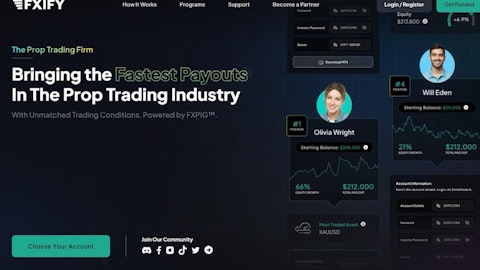So that has started and is continuing, and we are much, much more active again in those communities than we have been before, and we clearly see that’s a necessity also going forward. When it gets to the running, you have to remember that you’re competing against brands that have been in the running community for the last years and been very focused on it. And you also have seen that there are running what should I say, brands and has focused very much on what I call comfort running and everyday running, which also goes into to the lifestyle side of it. And we didn’t have a good offer on that. We have clearly focused in the beginning on racing. So we have done the best shoes to run the fastest from A to B, which is the most difficult and we’ve been very successful with our adizero and with the Evo range.
We have then built, I would say, a secondary line around Supernova, which is then going against, I would call, the running specialty brands like Brooks to compete there over time. And that’s very, what should I say, promising in the beginning. And then don’t forget, we had with UltraBOOST, with all the BOOST models, maybe the most comfortable running shoes that existed in the market. that also went lifestyle. And we are now reintroducing UltraBOOST 5, which is, what I would say, our comfort running play. And you will see more new launches going forward that is clearly target that consumer who doesn’t want to run the fastest from A to B, but have the most comfortable shoe to A to B and at the same time, assign the shoes in materials and colors that they can also be worn with jeans.
And that is always, I would say, the combination. So many, what should I say, initiatives on the running side both on the top end, which I feel very comfortable and then also competing against where the trend is currently, and I think we are on a good way of having the right product, and then we need to be a little bit patient to build that business. When it gets to LatAm, I’m looking at Harm because he’s the master of inflation. So he will answer on that.
Harm Ohlmeyer: Yes, there are 2 factors. I mean one is quite some piece of the 18% inflation-based price increases in Argentina. First and foremost, there are other markets as well, but it’s very pronounced in Argentina. And I think we get used to that as well. So part of the 18% is actually inflation in Argentina. But rest assured, there’s also volume growth overall in Latin America. So we believe we’re making good progress in many markets, and we’re gaining market share there, and this is definitely through volume growth. So I’m not going to give you now percentages of dissecting the 18% but there is volume growth. There’s a significant part, pricing and inflation in Argentina. But overall, we are making good progress in a very difficult market with a lot of volatility.
Sebastian Steffen: Alice, we have time for one last question now.
Operator: Today’s last question comes from the line of Aneesha Sherman with Bernstein.
Aneesha Sherman: So I have two, please. The first one is, this year, you’ve had a very successful franchise at the peak of brand heat. You’ve had a big increase in wholesale distribution. You’ve had some big — or you will have some big sporting events and some Yeezy sales. And next year, you’re going to be lapping all of this. And so as you think about next year’s growth, do you model Terrace growing at the same pace next year as well? Or do you think maybe the new launches that are coming out this year will have ramped quickly enough to make up for a slowdown in Terrace? Like how are you thinking about that algo versus what looks like a very strong year? My second question is on China. I think a couple of quarters ago, you talked about broadening the assortment and broadening the distribution to more mass price points where you see opportunities for share gain. Is that already happening? Or is that more of a 2025 opportunity?
Bjorn Gulden: When we model our lifestyle what should I say, franchises, we do that based on many factors. What is, of course, what the retailer wants to buy from us. The other one is the algorithm on what we’re selling out. And then it’s a combination of consumer groups and also, of course, social search. And when we look at it now, there is none of the franchises that we have talked about are slowing down and none of them are actually down when I get to demand going into ’25 from the retailers. That doesn’t necessarily mean that we will release those quantities. And this is what I’m saying is that behind Terrace, you have Campus. Behind Campus, you have SL72. Behind SL72, you have lo profile. Behind that, you’ve running lifestyle, and behind that, again, you have Superstar.
The work that we are doing is market-by-market trying then to see what is the right flow of that. And as I said, I think in the beginning, I feel we have a very thorough process in, what should I say, modeling and playing plan A, B, C, D within the time frame of what we can react on. And this is a new situation for us because we haven’t had 5 franchises working at any point in time the way it looks right now. So we will have to show you that we can do that. What we are modeling is continuous growth in the lifestyle area. But the mix of it when it gets to the different franchises in the different markets, as I said, have different scenarios. And all those scenarios are built in a way that we can react changing the production line in the factories from one model to the other model because, remember, we run these franchises on court in all the same factory groups.
So it’s a pretty, what should I say, easy way of changing. When it gets to China question, we especially said that on the performance side, we saw that the local brands have gained a lot of share in performance by building products in the price point €100 and below, where we didn’t really have a good global offer. So what we have done is that we build products both on the real performance side, but also on the, I would say, for example, running lifestyle on around 100, then we see — start to see traction on that. But Rome is not built in one day. So of course, the — what should I say, the visibility of these models will be much bigger in ’25 than in ’24 because we started this just 6 months ago. So we feel that we have given our Chinese team the resources and the tools, design, development, sourcing and marketing money to kind of cater for local demand, which partly is different than what it is in other parts of the world.
So they have a lot of creative freedom to utilize these resources to connect to the consumer. Again, I think when you look at the performance being up 8% and having a much cleaner inventory and having one of your colleagues had a huge improvement on the EBIT line in Q1, but things are starting to work in a way that we’re very proud of what the local team has done, knowing that we will have to continue to take share and knowing that the business in China can still be uncertain and volatile given all the external factors. But I think we feel a lot better today than we did 12 months ago.
Sebastian Steffen: All right. Thanks very much, Aneesha. Thanks very much, Alice, and thanks very much also to Bjorn and Harm. And of course, also thanks to all of you for participating in our call today. This concludes our Q1 results call. As always, if there’s any questions left, please free to reach out to Adrian, Philip, myself or any other member of the IR team. We were very much looking forward to chatting with you over the next couple of days and weeks. And with that, as Bjorn said, let’s all enjoy the summer of sports starting with an all adidas Champions League, semi-final tonight. All the best. Bye-bye. Take care.
Follow Adidas Ag-Sponsored Adr (OTC:ADDYY)
Follow Adidas Ag-Sponsored Adr (OTC:ADDYY)
Receive real-time insider trading and news alerts





